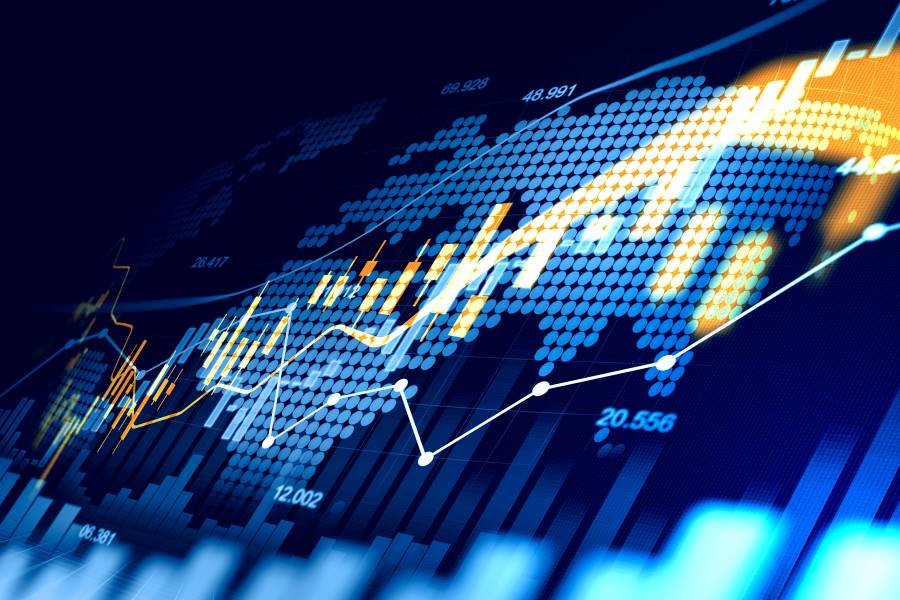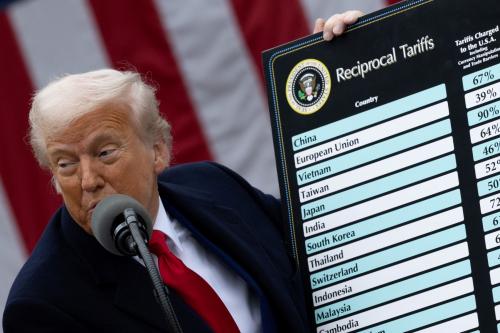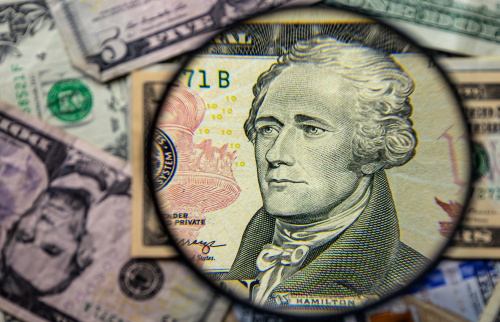In collaboration with the Financial Times (FT), Eswar Prasad of Brookings and Caroline Smiltneks of Cornell have constructed a set of composite indexes that track the global economic recovery. The Tracking Indexes for the Global Economic Recovery (TIGER) is also featured in the Financial Times. A version of this article also appears in Project Syndicate.
See the October 2025 update to TIGER for the latest analysis.
The timing could hardly have been less propitious. Just as the world economy was showing signs of stabilizing, the odds of a policy-induced global recession sparked by escalated financial market volatility and policy uncertainty have risen significantly. The latest update of the Brookings-FT TIGER (Tracking Indexes for the Global Economic Recovery) reveals a mixed picture, with the financial index crumbling and private sector confidence plunging even as macroeconomic data, which lag the other indicators, suggest a more benign scenario. The Trump tariffs have disrupted world trade and set off turmoil in financial markets, damaging growth prospects that had looked promising at the start of the year.
The U.S. economy performed well in the first quarter of 2025, with robust output and employment growth through March and with inflation gradually drifting down. All of that changed in April with Trump’s announcement of reciprocal tariffs aimed at practically all U.S. trading partners. Financial markets were severely roiled, with the subsequent pause on tariffs (except those applied to imports from China) and various carve-outs doing little to quell the whiplash effect. The uncertainty has severely dented consumer confidence and is likely to take a toll on business investment and employment growth. The Federal Reserve’s ability to support the economy and forestall financial turmoil will be constrained by the pass-through of tariffs into domestic inflation. The tariff bloodbath has elevated the probability of the U.S. economy stalling, even as U.S. policymaking seems ever more unpredictable and whimsical.
Select a country below to view its composite chart and download its main TIGER charts.
The eurozone economy continues to operate on two tracks. Core economies such as Austria, France, and Germany remain mired in low growth and face enormous fiscal pressures, particularly as political turmoil pushes up borrowing costs. By contrast, the economies of Greece, Italy, Portugal, and Spain have held up better. Disruptions to international trade are likely to take a toll on manufacturing powerhouses in Europe and elsewhere. The Japanese and U.K. economies were experiencing modest growth but their underlying fragilities, and lack of room for policy maneuver, are likely to be exposed by trade tensions.
China’s economy, which had been steadying after a rough patch, now faces major challenges. Expanding industrial capacity has not been matched by domestic demand, as reflected in persistent deflationary pressures, making China particularly vulnerable to an all-out trade war with the United States. China has faced escalating U.S. tariffs with bravado, retaliating with its own tariffs on U.S. imports and other measures meant to inflict pain on the U.S. economy. However, there is a limit to this strategy given China’s weak economy, especially as other countries are already taking steps to fend off the prospect of a flood of Chinese exports landing on their shores. China does have room to deploy fiscal and monetary policy tools to bolster domestic consumption, but these are likely to prove effective only if supplemented with broader reforms that serve as confidence-building measures.
India’s economy continues to perform well, fueled by strong rural consumption and a robust services sector. Expanding domestic demand, resilient financial markets, and its role as an alternative supply chain base as U.S. corporations shift out of China have insulated India from the worst of the repercussions of tariffs. In Brazil, an uptick in consumer spending helped offset declining exports in 2024, but loose fiscal policy and the resulting inflation and weak real, along with tumbling consumer and business confidence, suggest a challenging year ahead. South Africa is struggling with persistent power shortages, sluggish growth, and a weakening currency.
The twin shocks of U.S. tariffs and rising excess capacity in China will severely crimp growth in emerging market and developing countries, such as those in Southeast Asia that are heavily reliant on exports. Trade disruptions, growing debt-servicing burdens, and scaled-back foreign aid flows as the major economies recalibrate their spending will exact an especially high toll on low-income countries in Africa and elsewhere.
The era of increasingly free and unfettered trade has come to a crashing end as the Trump tariffs lead to a widespread surge of protectionist measures. Trump has taken the hatchet to trade with practically every major U.S. trading partner, sparing few allies or rivals and setting off a new era of protectionism that will reverberate worldwide.
A full-scale retreat is hardly in prospect but, no matter how the tariffs eventually play out, patterns of international trade are shifting. In fact, even before Trump wielded his tariff hatchet, trade was already becoming fragmented in line with growing geopolitical fissures. Finance tends to follow trade, so trade fragmentation is resulting in weaker overall economic linkages between countries. Even if the tariff wars ease up as the economic consequences sink in, corporations around the world are now forced to confront a much more uncertain and volatile trade landscape.
It is premature to assert that a worldwide recession is around the corner, but the breakdown of global trade and elevated policy uncertainty will undoubtedly suppress growth. Each country will need to conserve whatever macro policy space it has and deploy those tools to maximum effect if growth slows down sharply. Reforms to make their own economies more flexible and resilient, along with measures to boost domestic demand, will become crucial for weathering the turbulence.
The Brookings Institution is committed to quality, independence, and impact.
We are supported by a diverse array of funders. In line with our values and policies, each Brookings publication represents the sole views of its author(s).







Commentary
April 2025 update to TIGER: The world economy shudders and could stall
April 20, 2025